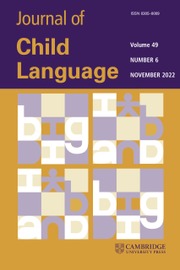Crossref Citations
This article has been cited by the following publications. This list is generated based on data provided by
Crossref.
Sperber, D
1995.
Relevance theory explains the selection task.
Cognition,
Vol. 57,
Issue. 1,
p.
31.
Gutierrez-Cleflen, Vera F.
and
DeCurtis, Lisa
1999.
Word Definition Skills in Spanish-Speaking Children with Language Impairment.
Communication Disorders Quarterly,
Vol. 21,
Issue. 1,
p.
23.
Nippold, Marilyn A.
Hegel, Susan L.
Sohlberg, McKay Moore
and
Schwarz, Ilsa E.
1999.
Defining Abstract Entities.
Journal of Speech, Language, and Hearing Research,
Vol. 42,
Issue. 2,
p.
473.
Nippold, Marilyn A.
Allen, Melissa M.
and
Kirsch, Dixon I.
2000.
How Adolescents Comprehend Unfamiliar Proverbs.
Journal of Speech, Language, and Hearing Research,
Vol. 43,
Issue. 3,
p.
621.
Foster-Cohen, Susan H.
2000.
Relevance: communication and cognition.
Second Language Research,
Vol. 16,
Issue. 1,
p.
77.
Dockrell, Julie E
Messer, David
George, Rachel
and
Ralli, Assimina
2003.
Beyond naming patterns in children with WFDs—definitions for nouns and verbs.
Journal of Neurolinguistics,
Vol. 16,
Issue. 2-3,
p.
191.
Hughes, Diana
Woodcock, Jayne
and
Funnell, Elaine
2005.
Conceptions of objects across categories: Childhood patterns resemble those of adults.
British Journal of Psychology,
Vol. 96,
Issue. 1,
p.
1.
Funnell, Elaine
Hughes, Diana
and
Woodcock, Jayne
2006.
Age of acquisition for naming and knowing: A new hypothesis.
Quarterly Journal of Experimental Psychology,
Vol. 59,
Issue. 2,
p.
268.
Marinellie, Sally A.
and
Chan, Yen-Ling
2006.
The Effect of Word Frequency on Noun and Verb Definitions: A Developmental Study.
Journal of Speech, Language, and Hearing Research,
Vol. 49,
Issue. 5,
p.
1001.
Harley, Trevor A.
Jessiman, Lesley J.
MacAndrew, Siobhan B. G.
and
Astell, Arlene
2008.
I don't know what I know: Evidence of preserved semantic knowledge but impaired metalinguistic knowledge in adults with probable Alzheimer's disease.
Aphasiology,
Vol. 22,
Issue. 3,
p.
321.
Marinellie, Sally A.
2009.
The content of children's definitions: The oral-written distinction.
Child Language Teaching and Therapy,
Vol. 25,
Issue. 1,
p.
89.
Teberosky, Ana
and
Portilla, Claudia
2011.
Los “contrarios” en el aprendizaje inicial del lenguaje escrito.
Cultura y Educación,
Vol. 23,
Issue. 4,
p.
515.
Belacchi, Carmen
Benelli, Beatrice
and
Pantaleone, Silvia
2011.
The influence of categorical organization on verbal working memory.
British Journal of Developmental Psychology,
Vol. 29,
Issue. 4,
p.
942.
To, Carol Kit Sum
Stokes, Stephanie
Man, Yonnie
and
T’sou, Benjamin
2013.
An Analysis of Noun Definition in Cantonese.
Language and Speech,
Vol. 56,
Issue. 1,
p.
105.
Gablasova, Dana
2014.
Issues in the assessment of bilingually educated students: expressing subject knowledge through L1 and L2.
The Language Learning Journal,
Vol. 42,
Issue. 2,
p.
151.
Dourou, Chrisoula
Gavriilidou, Zoe
and
Markos, Angelos
2020.
Definitional skills and preferred definition types according to age, gender, educational level and career orientation.
International Journal of Research Studies in Education,
Vol. 9,
Issue. 2,
Paulino, Vicente
2020.
Linguagem como um Sistema Formal e Rede de Práticas da Comunicação..
Diálogos,
Vol. 5,
Issue. ,
p.
159.
Artuso, Caterina
Palladino, Paola
and
Belacchi, Carmen
2020.
Sensitivity detection in memory recognition: interference control as index of taxonomic memory development?.
Memory,
Vol. 28,
Issue. 2,
p.
187.
Belacchi, Carmen
and
Benelli, Beatrice
2020.
Meta-Representational Skills in Bullying Roles: The Influence of Definitional Competence and Empathy.
Frontiers in Psychology,
Vol. 11,
Issue. ,
Bianco, Federica
Castelli, Ilaria
and
Belacchi, Carmen
2022.
Changes of Meta-Representational Skills in Ageing: First Empirical Evidence on the Relation between Metalinguistic Competence and Attributions of Mental States.
Journal of Language and Education,
Vol. 8,
Issue. 3,
p.
40.

